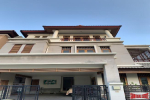2022/04/19 in Latest news - 131
Thailand Property Maintenance Fees / CAM Fees Explained
What are maintenance fees / CAM fees? How often are CAM fees paid? What do CAM fees cover? How are maintenance fees calculated?
Maintenance fees, also called common area maintenance (CAM fees), can be different amounts depending on the property or development. Maintenance fees can be paid monthly or semi-annually, however sometimes they are requested a year in advance.
Maintenance fees pay for general up-keep and repair of the common areas. These expenses include the swimming pool, gym, reception, gardens, elevators, security staff, walkways and other communal shared areas. The maintenance fee can cover other common areas expenses not listed above depending on the project.
These fees typically range from 40 to 70 THB per square meter. Although bigger projects with more luxurious selections of facilities or bigger areas of upkeep may have higher maintenance fees.
Major projects or repairs are usually not covered with the maintenance fees, however in some cases they do cover basic repairs. It is suggested that you check with the management company and the by-laws of the condominium to find out what is and what is not covered with the maintenance fees.
Sinking Fund Explained
What is a sinking fund? What is the sinking fund used for?
New condos and villa projects have a reserve called the sinking fund. This is a common fund paid by all new owners of the project or property. The reserve sinking fund is typically used for major repairs, repainting, equipment replacement, structural fixes and other large expenses that occur only once in a while. The sinking fund is calculated by the price per square meter of the living area of the property and is paid up front during the purchase process of a brand new property and again when the sinking fund needs replenishing.
The sinking fund is a separate reserve fee and is different from the maintenance fees. Buyers pay into the sinking fund on new residential properties.
The juristic department of the project is in charge of allocating the sinking fund and should provide transparent records to the owners. The owners with voting rights will collectively vote to determined where and when the fund should be spent.
Occasionally the fund may need to be replenished after a number of years. This is done upon the agreement of all people involved in the project including the developer and a vote of all owners.
In conclusion, the basic difference between the sinking fund and maintenance fees is that the sinking fund is not collected on a regular basis. It is paid upon the original purchase of a new condo or villa. It can be topped off again at a later date depending on the collective decision of the owners for large necessary maintenance projects.





